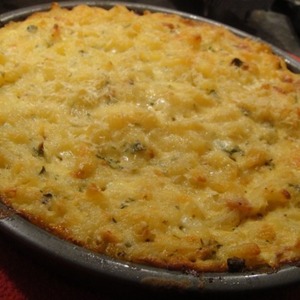Ingredients
Equipment
Method
- Preheat your oven to 375°F (190°C). Butter a 9x13-inch baking dish.
- Bring a large pot of salted water to a boil. Add the elbow macaroni and cook just under al dente according to package directions. Drain and set aside.
- In a large Dutch oven or heavy-bottomed pot, heat the olive oil over medium-high heat. Add the diced pancetta and cook until crispy and golden. Remove the pancetta with a slotted spoon, leaving the rendered fat in the pot.
- Reduce heat to medium. Add the finely chopped garlic to the pot and sauté for 30 seconds until fragrant. Whisk in the flour and cook, stirring constantly, for 1-2 minutes to create a roux.
- Gradually whisk in the hot whole milk until the sauce is smooth and thickened. Bring to a gentle simmer.
- Remove the pot from the heat. Stir in the finely chopped fresh thyme leaves, cayenne pepper, and most of the grated Asiago, Irish white cheddar, American cheddar, and aged Fontina cheeses until melted and smooth.
- In a separate bowl, lightly whisk the egg yolks. Gradually whisk a ladleful of the hot cheese sauce into the egg yolks to temper them. Slowly pour the tempered egg mixture back into the pot with the remaining cheese sauce, whisking constantly until fully incorporated. Season with kosher salt and freshly ground black pepper to taste.
- Add the cooked macaroni to the cheese sauce, tossing gently to coat all the pasta evenly.
- Pour the macaroni and cheese mixture into the prepared baking dish. Sprinkle the remaining grated cheeses, along with the Parmesan, over the top.
- Bake for 25-30 minutes, or until the top is golden brown and the sauce is bubbly. Let stand for a few minutes before serving, garnished with fresh flat-leaf parsley.
Notes
This dish thrives on rich, balanced flavors. For optimal texture, cook your macaroni just under al dente; it will finish cooking in the oven and absorb the creamy sauce without becoming mushy. When incorporating the whisked egg yolks, temper them properly by gradually whisking a small amount of the hot sauce into the yolks first, then slowly adding the warmed yolk mixture back into the main sauce. This prevents curdling and ensures a silky, carbonara-like finish. Use freshly grated cheeses for superior melting and flavor. The combination of Asiago, cheddar, fontina, and Parmesan offers a complex profile. Don't skip the cayenne; it adds a subtle warmth that elevates the dish without making it spicy. Ensure your milk is hot when adding to the roux for a smoother béchamel.
